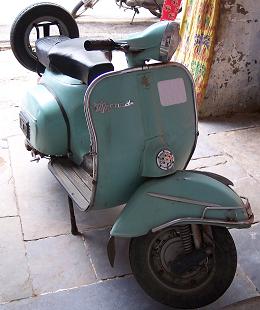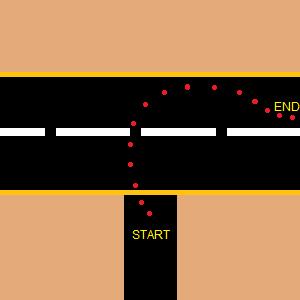It’s hardly six months since Bajaj Auto Ltd announced its withdrawal from the scooter market in India. This essentially meant that one of the common household names and valiant family carrier – the Bajaj Chetak – faced a total phase-out.
Hamara Bajaj Chetak
 The Bajaj scooter – ‘Hamara Bajaj’ as in Rahul Bajaj’s most successful campaign – has been there in the Indian market for almost 40 years with three models – the most successful Chetak, Super and 150. For the middle class Indian family consisting of a husband, wife and two to four kids, this vehicle was like their family member that carried the entire family and their accessories through the rough roads and under all kinds of weather conditions. Its toughness and low maintenance cost made it super successful in India though the surge of Japanese two-wheelers in the mid 80’s slowly forced it out of the game. It is really hard to forget some of those scenes that all of us have witnessed, admired and laughed at times.
The Bajaj scooter – ‘Hamara Bajaj’ as in Rahul Bajaj’s most successful campaign – has been there in the Indian market for almost 40 years with three models – the most successful Chetak, Super and 150. For the middle class Indian family consisting of a husband, wife and two to four kids, this vehicle was like their family member that carried the entire family and their accessories through the rough roads and under all kinds of weather conditions. Its toughness and low maintenance cost made it super successful in India though the surge of Japanese two-wheelers in the mid 80’s slowly forced it out of the game. It is really hard to forget some of those scenes that all of us have witnessed, admired and laughed at times.
The retro-commercial featuring Hamara Bajaj
Peculiar things about a Bajaj scooter
Though there are variations across different models, the typical Bajaj scooter weighs around 110Kg. However, it could pull double its weight without causing much trouble.
Since the engine is planted on the right side, it always had an imbalanced while riding whereby the scooter tends to move towards the right if you are not careful. This was one of the issues for beginners who tried their hands on a Bajaj.
To fix this problem, they in fact placed the tyres in an offset position. In other words the front and rear tyres are not in a straight line but has a slight offset. I was surprised to learn this from one of the old timers that I have known.
The split seats were never designed with the ergonomics in mind but the need to accommodate the ever-responsible family head and the fat-bottomed typical Indian house wife and their kids (in all available gaps)
How to start a Bajaj Chetak – the sequence of operations
This is the funniest part. From what I have seen and witnessed it involves the following operations in exact same sequence.
1. Insert the ignition key in the handle lock keyhole. Turn the key vigorously three to four times while simultaneously turning the handle to make sure that it is unlocked. I hear from people that at times, it can get locked during the ride as well?
2. Take the vehicle off the centre stand with a ‘thud’ (of the stand hitting the bottom of the scooter). To effectively do this, you have to have your left hand on the left handle of the vehicle and your right hand on a little handle behind the rider’s seat which is always kind of loose. You have to be leaning forward at an angle of 60% with respect to the ground level in order to effectively manage this.
3. Push the vehicle to a flat surface and while doing so for some weird reason you have to always pull the clutch lever. Or is it just a habit?
4. Now, you are on the left side of the vehicle but the kick starter is on the other side. So, you have to enter through the wide open space between the handle and the front seat and get to the other side. It is a process that’s religiously followed and it reminds me of entering the house from the front door and exiting via the kitchen or backdoor.
5. Now, tilt the vehicle to the other side by about 30 degrees and hold it in that position for 5-10 seconds in order to make sure that the little petrol remaining in the vehicle reaches all vital parts (or areas that matter) of the engine. Even when the vehicle has recently undergone a full service/maintenance, you have to do it because you are so used to doing it.
6. Straighten the vehicle, suddenly climb the kick starter lever and force all your weight on it and simultaneously turn the accelerator handle vigorously (four to five times a second). Subsequently – if it’s going to start that is – it gives out an engine roar along with a pale cry of the horn owing to loose electric connections. More often than not, throughout the ride, you get to hear that sound.
7. Now occupy yourself by entering from the right side and allow your co-passenger(s) to settle. You have to keep turning the throttle or the entire sequence need to be repeated.
8. Engage first gear and while leaving the clutch lever, it invariably jerks and jumps due to a slipping clutch or gearbox unit.
…and there you go…
While on the ride…
Immediately after the take off, the most important thing that you will notice is that the rider, after engaging into second gear, will suddenly raise his bum and readjusts himself. This is due to the fact that the front split seat is leaning way too forward. This adjustment happens once in a while throughout the journey, especially after taking off from traffic lights.
The pillion rider, if it is a lady, will be usually sitting in an awkward sideways position whereby she will be holding her right hand on to her husband (rider)’s right shoulder or the loose handle behind the front seat. Her left hand will be usually on the support handle/spare tyre (fondly called a stepney) holder behind the rear seat. She will then bend all the way front and look over her husband’s left shoulder so as to quickly jump down in case of an emergency.
Due to the imbalance of the vehicle weight, you have to dedicate an extra 10% of your body weight towards the left side. However, this can vary based on how much weight your pillion rider is bifurcating to each side.
The rider will never use the turn indicator lamps (blinkers) because this feature is something that was introduced in later models and he is not used to it. The horn, with whatever feeble sound it has, itself is rarely used.
 When typical Bajaj scooter rider, enters the main road from a side road, he usually takes wide 90 degrees turn – in fact 3/4th of a circle – before merging into the center of the road. This invariably causes some concerns among other drivers on the road, but they would expect this and manage the situation. See the illustration below to understand what I am talking about.
When typical Bajaj scooter rider, enters the main road from a side road, he usually takes wide 90 degrees turn – in fact 3/4th of a circle – before merging into the center of the road. This invariably causes some concerns among other drivers on the road, but they would expect this and manage the situation. See the illustration below to understand what I am talking about.
A Bajaj family = A happy family
Jokes apart, the middle class family, on a bajaj scooter, was always such a happy scene for a typical Indian and we adored that togetherness for a couple of generations. It often depicted the resilience of the upcoming Indian or a small business man who struggled to make both ends but emerged successful at the end. It was this kind of families – headed by those individual who drove their entire family to safety every single day – that paved foundation to the kind of growth that we are witnessing at the moment. In fact, in the 70s and 80s people used to yearn for owning a bajaj and waited for six months or one year after placing the order, in order to get their family dream scooter delivered.
I just thought of spending some time to write about the legendary vehicle because we all will be soon forgetting what we came through.
Long live hamara bajaj!
